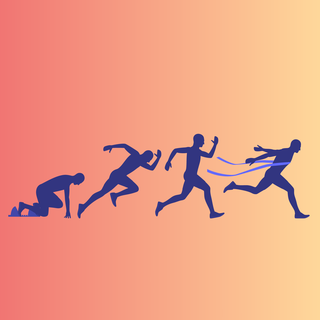
20 years in, the Agile Manifesto revolution continues
Lucid Content
Reading time: about 9 min
It was the year Apple gave all of us the ability to have “a thousand songs in your pocket” with the introduction of the iPod. Microsoft entered the console game world with the Xbox. Wikipedia and Google Image Search both launched. Ericson released the first Bluetooth-capable phone.
But for software developers everywhere, 2001 is better known as the year that Agile was born.
The result of a two-day meeting between 17 like-minded professionals at Utah’s Snowbird ski resort, the Agile Manifesto ushered in a revolutionary approach to coding. One that offered an alternative to existing “documentation-driven, heavyweight software development processes.”
To understand the benefits of Agile today, let’s take a look at the history of Agile development.
The history of Agile development
Before the Agile Manifesto, software developers worked within a system of command and control.
Workflows primarily consisted of project management handing over tasks and then wanting to know if everything would be completed by the end of the day. Coders were often considered low-level contributors, unable to think about the big picture or the customers’ needs.
The principles explained in the Agile Manifesto radically changed the landscape of both software development and project management in favor of leaner, faster, and more experimental ways to drive production.
What started as an effort two decades ago to free the developer community from “the baggage of Dilbertesque corporations” and fixed-process mindsets changed everything and introduced the Scrum, Adaptive Software Development, and Extreme Programming processes that are so popular today.
This new way of working and thinking created Agile frameworks along with a fresh set of values.
Agile Manifesto values
The Agile Manifesto is made up of four foundational values that outline its lightweight approach to iterative software development. This approach is based on adapting processes to fit the dev team, not vice versa.
The Agile lessons learned and expressed as values (or guiding principles) are as follows:
- Individuals and interactions over processes and tools: Communication between everyone working on a project is favored over strict adherence to process.
- Working software over comprehensive documentation: Documentation is still part of the process with Agile, but in a more fluid way that gives developers the freedom to operate.
- Customer collaboration over contract negotiation: Among the many benefits of Agile development is the inclusion of customer input from start to finish.
- Responding to change over following a plan: According to Agile Manifesto principles, change highlights the potential to improve a project and not as a cost to be avoided.
Over the past two decades, the influence and reach of Agile Manifesto principles have extended far beyond improved working relationships between software developers and project managers. The core benefits of Agile development now shape how teams across organizations and industries view their work.
What we’ve learned from Agile
Looking back on the history of Agile development, it’s clear today that the Agile Manifesto broke new ground. Though it began as an alternative for simplifying the software dev process, many of us rely on Agile principles (and many other Agile lessons learned) without even knowing it.
In an increasingly complex, often ambiguous world, the predict-and-plan approach of controlling outcomes to achieve results has gradually given way to Agile’s sense-and-respond mindset. By acknowledging that the future is uncertain, we’ve gained more freedom to innovate and adapt.
Here are more examples of the Agile lessons learned and embraced by the modern workplace.
Making the workplace more human: A paradigm shift
Before the Agile Manifesto, conventional wisdom in software development was that people were secondary to the processes they followed. Software developers were not asked (or encouraged) to help solve problems, create efficiencies, or offer any insights outside of their coding expertise.
Once Agile Manifesto principles became more commonplace among technology companies, the quality of communication within teams began to show a greater impact on work-output quality.
Agile development validated that software isn’t written for machines, but rather for the people who become its end users. Without an understanding of what people really want, having an ambitious project timeline or comprehensive documentation would never be enough.
As a result, Agile changed modern management theory and branched outside of technology.
But the changes weren’t just about considering the needs and wants of end-users. They also impacted the workplace. The concept of work-life balance that many of us take for granted is due in part to the Agile Manifesto and its principles. Pandemic or not, imagine for a moment the large-scale adoption of working from home without the Agile practice of team communication over blind process alone. Additionally, Agile has helped encourage people to be themselves.
Because of Agile, employees are no longer confined to rigid schedules or arranged seating. It’s hard to imagine the quick implementation and acceptance of today’s WFH norm without Agile and its emphasis on creativity, collaboration, and communication.
Why? In an Agile workplace, people enjoy a greater sense of autonomy and are valued for what they alone bring to the table. Outcomes take precedence over attendance. Differing viewpoints thrive in Agile’s sense-and-respond environment and people are trusted to work how they want.
Employees can now feel empowered to play to their strengths, work more effectively as a team, and fairly share the burden of delivering critical projects on time, on budget, and to expectations.
The Agile view of people and the world
Regardless of their size or industry, most businesses today are tasked with addressing priorities that are rarely static. Adopting an Agile mindset makes it easier to adapt to everything from changes in the marketplace to shifting customer preferences while also boosting performance.
In the Agile worldview, practically any work discipline can be seen as a creative endeavor with a human element at its core. When trust is second nature, accountability and ownership thrive.
This accountability is not limited to accepting responsibility for one’s actions, but it extends to sharing thoughtful insights about why choices are made and seeing what impact they had on outcomes. In the Agile view, failure is no longer taboo. Rather, experimentation (and, yes, failure) are the dues one pays to realize success.
Transparency and collaboration among people to achieve results are what really matters most.
The rise of Agile represents a mindset shift throughout corporate America. One of the benefits of Agile development which has now found a place in fields beyond technology is the flexibility to change priorities from day to day and tackle new objectives in less than a month (the typical time associated with sprints for Agile teams).
Take the daily standup meeting favored by so many organizations. This daily meeting is a result of the Scrum meeting and sprint planning practices familiar to those with work backgrounds in Agile development and spotlights democratization in the workplace where everyone enjoys an open platform to share their ideas and provide feedback.
Because of the camaraderie inherent to Agile and its many elements, the modern workplace benefits from an atmosphere of trust where participation is encouraged and ideas can come from anyone regardless of role.
Agile provides a model for rapid learning and addressing uncertainty
When people are treated equally and expected to contribute ideas, the capability to learn rapidly and address uncertainty increases. Agile development demonstrates that the strength of a team is exponentially greater than the sum of its members.
One of the most important Agile lessons learned and adopted by non-Agile teams today is how each individual must be vested in the entire team’s success, especially if a team is small.
Naturally, freedom and latitude to operate come with added responsibility. In an Agile environment, teams are only as strong as their weakest links. Whenever there’s a setback or failure, Agile demonstrates that focusing on the problem (not blaming others) is the answer.
By approaching projects with an Agile mindset, teams ensure that problems and uncertainties won’t go unnoticed for very long. Taking the sprint mentality of Agile teams, the window for error correction is weeks, not months.
How we expect Agile to evolve in the years ahead
It’s obvious the benefits of Agile development are no longer confined to software development, or even to the workplace. The influence of Agile can be seen in continuous self-reflection and the desire to maximize efforts. Think about the ongoing rise of fitness apps, wearable smart devices, and Wi-Fi-enabled exercise equipment. Those are all the results of the improvement-by-iteration, Agile mindset.
Our renewed focus on personal growth and methods for addressing uncertainty demonstrates how Agile has made its way beyond the workplace and into the rest of our lives. Everyone can benefit from Agile lessons learned in focusing on specific tasks, setting aside time to complete them, and breaking down long-term goals into smaller, attainable ones to make actual progress.
The Agile mindset will continue to expand into other disciplines. For example, Agile could shape how financial agreements, exclusive partnerships, and sales contracts are negotiated. Typically, such deals are highly dependent on agreeing to terms, all backed by extensive documentation.
This is a natural environment for the evolution of Agile. For one, risk is better mitigated when the principles of the Agile Manifesto are followed and when customer interactions occur throughout the entire process. Past agreements can be adjusted in real time whenever circumstances change.
The Agile approach can even be witnessed within the realm of public health. The recent response to COVID-19, including the organization of rapid vaccine prototyping with pharmaceutical corporations and the coordination of vaccine deployment, bears the hallmarks of Agile.
Although human interaction should be the emphasis over technology, whenever technology can provide us with more engaging ways to communicate or break down barriers, we’re better for it. In our pursuit of continuous improvement, we must embrace the tools that allow us to respond to scope changes in a fluid manner, independent of linear phases or predetermined sequences.
For example, the Lucid visual collaboration suite gives teams access to a dynamic platform that allows them to quickly iterate and share ideas, easily communicate with team members across platforms and time zones, and place a premium on interaction over process alone. Whichever tools we use to ensure our productivity in an uncertain world, we can feel certain that the Agile lessons learned over the past two decades will continue to be relied upon for years to come.

Over the last 20 years of Agile, there have been many apps and techniques introduced to support it. Learn how Lucidchart can help your team go agile.
Read moreAbout Lucidchart
Lucidchart, a cloud-based intelligent diagramming application, is a core component of Lucid Software's Visual Collaboration Suite. This intuitive, cloud-based solution empowers teams to collaborate in real-time to build flowcharts, mockups, UML diagrams, customer journey maps, and more. Lucidchart propels teams forward to build the future faster. Lucid is proud to serve top businesses around the world, including customers such as Google, GE, and NBC Universal, and 99% of the Fortune 500. Lucid partners with industry leaders, including Google, Atlassian, and Microsoft. Since its founding, Lucid has received numerous awards for its products, business, and workplace culture. For more information, visit lucidchart.com.
